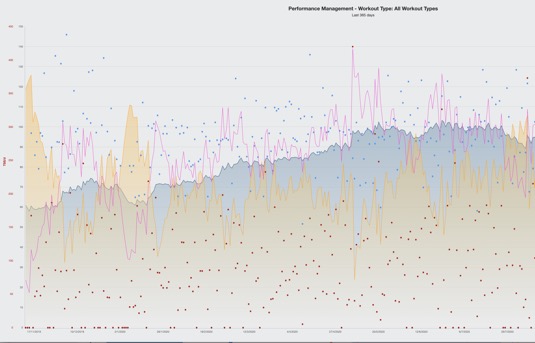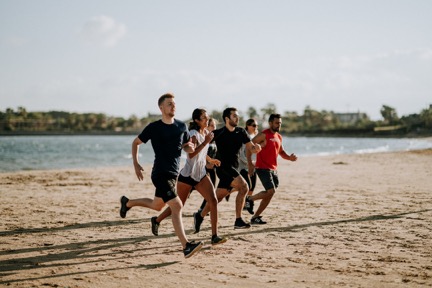
Keeping it Fresh
11/11/20 10:35
This time of year can sometimes feel like a lost or difficult time of year to transition your training.
I certainly get the same feeling, but years of experience has taught me how to work with this time of year, rather than let it get you down.
If you're someone who fears losing all the fitness you've gained through the year, it can be quite an anxious time. This can then be compounded if you use apps which show a fitness score such as TrainingPeaks.
We suddenly see that fitness score taking a nose dive and the self guilt can take over which can lead to a fairly miserable time mentally.
Well, fear not.
First we need to look at the fitness score and understand what its telling us. Different apps or software packages use different calculations, so I won't go into the full ins and outs as to how they all work.The basic is that they use equations using all your training data and come up with your score. Now that is an amazing tool to use both for coaches and athletes in order to see progression.
The thing to be comfortable with here is that those scores are a guide, they aren't an exact. If you work together with a coach, speak with them if you do get hung up on the data, and they will be able to explain where you are with it.
If you think about the progression you make through the winter into spring, then a lot of that work is structured to lift your fitness in a nice controlled manner, this is where working with your coach really comes in.
Now that progression takes structured sessions which build over a long period of time which generally also requires longer duration through your training period as well. Put all those pieces together and you see your fitness score gradually come up over a long spell of time, which is purposeful and again together with a coach is tailored to you.

So now your main goals may be finished for the year, and the next ones are quite a way in the distance, so of course we generally kick back a little. This is where some planing comes in and you can research your previous data.
If you look at your fitness score now and compare to this same time last year, how does it compare? Are you roughly the same, down a little or up a little or a lot?
If you're up on that last years number, happy days, if you're roughly the same, great. If that number is down, that's no problem, but you may need to look at how your progression is going to go from here forward.
No matter what, getting back to your desired level of fitness is achievable, but having patience is the key. The saying Rome wasn't built in a day springs to mind.
So let's look at this from another angle. If our fitness score stayed high all the time, how do we keep progressing?
Unless you're retired or a full time athlete most of us have to fit training around work, family, and other things going on in our lives. So what we tend to get is a top out point where we will hit a certain level and it then becomes extremely difficult to make big gains after that.
The key here is working with our available time and trying to hit that optimal level for your main events or goals. If we tried staying at that level year round, trust me, you will just end up fatigued and miss your mark all together for those main goals.
What we then need to do is throttle back a bit this time of year and look forward to that progression going on its upward cycle again. So really if you let yourself relax and recharge, you end up with an exciting prospect of seeing that fitness score creeping back up, which has a huge mental benefit.
Again, refer back to what I said before, look at where you are now compared to this time last year. What we don't really want to do is ease back so much that we drop off a cliff. We want just enough rest and recovery to give us a nice springboard to hit our first target in good shape. If that target is 3 months away for example, just how much can you let yourself ease back? If you're very experienced you may know that, if not, that can be difficult to know.
Mix it up
This is where the part comes in which is something I've always done in my training, it's not top secret or cutting edge, its actually quite simple.For me keeping the mind fresh is the biggest aspect for this time of year. If I carried on hammering my bike every day through wind, rain, or even sat on the turbo everyday, I know my mood wouldn't be great by the time I got to spring.
So I like to use a variety of other sports and keep things fresh, which also benefit neglected areas of our hunched over non extending bodies if you're a cyclist anyway.

Look at sports you enjoy, perhaps you came from another sport and would like to do some again through the winter. Go for it, you're going to meet old and new friends, no doubt there will be a social aspect to it with a different group of people, again great for the mind.
You may have a sport you'd like to try, why not give it a go, you may actually find the physical benefit will cross over to your main sport.
For me, I traditionally use running and weight training. Of course weight training is great to use year round, but we can now focus more on the strength aspect of it.
Running is a great workout for cardio which can take as little as 20 minutes. If its not your main sport, I'll guarantee you won't be efficient enough to find it easy, so it makes for a great threshold session without thinking about doing a threshold session.
Swimming as I'm now learning is a great workout, if you can swim gracefully, I'm very jealous, but again a brilliant alternative to just riding the bike.

Out of all of this, the main focus point is to keep the mind fresh. Do things you enjoy, and also new things that challenge you. When the hard work starts again, you'll be mentally rested and ready for it.
Comments
Bike Fitting
Coaching
Cycling
Event
Insoles
Ironman
Ladies
Marathon
Racing
Recovery
Reviews
Running
Skills
Sport
Tips
Training
Triathlon
Coaching
Cycling
Event
Insoles
Ironman
Ladies
Marathon
Racing
Recovery
Reviews
Running
Skills
Sport
Tips
Training
Triathlon
